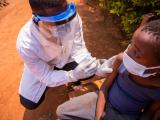During the first year of the COVID-19 pandemic, adults in four US states who had telework experience before infection were less likely to work on site but more likely to work at all during their illness than those without such experience, finds a study yesterday in Emerging Infectious Diseases.
The study also showed that COVID-infected workers were less likely to work on site than those who had other respiratory diseases, and about 6% of infected employees with telework experience worked on site while sick.
A team led by Oak Ridge Institute for Science and Education and Centers for Disease Control and Prevention (CDC) researchers surveyed 947 workers aged 18 to 69 years who were infected with SARS-CoV-2 or other respiratory illnesses in Michigan, Texas, Washington state, and Pennsylvania from March to November 2020, before COVID-19 vaccines were available.
They aimed to determine rates of presenteeism, or working while ill, among adults seeking COVID-19 testing or outpatient care for fever, cough, or loss of taste or smell of less than 10 days' duration at designated sites. Participants provided respiratory specimens at enrollment and completed surveys at enrollment and within the next 28 days. Telework experience was defined as at least 1 hour of remote work per typical week before COVID-19 infection.
The researchers noted that, starting in the first year of the pandemic, public health officials urged businesses to implement infection-mitigation protocols in the workplace, including symptom and temperature checks, mask requirements, physical distancing, and allowing remote work, providing paid sick leave, and encouraging ill workers to stay home.
On Apr 1, 2020, the federal government began giving financial aid to workers and businesses and mandated employers to provide paid sick leave or expanded family and medical leave to staff who couldn't work because of COVID-19. "Nonetheless, outbreaks of COVID-19 in workplaces have been reported, in part attributed to presenteeism," the study authors wrote.
Telecommuters worked more days
The median interval between symptom onset and specimen collection was 3 days, from onset to COVID-19 testing was 5 days, from onset to enrollment was 6 days, and from onset to follow-up was 15 days.
Of the 947 participants, 24.4% had COVID-19, and 75.6% had other respiratory illnesses. Relative to respondents with no telework experience, those who had worked from home were more likely to become ill during fall than spring (46.8% vs. 34.8%) and have higher education levels and were less likely to be a healthcare worker (36.6% vs. 52.7%) and to have COVID-19 (15.1% vs. 27.0%).
Participants with telework experience were less likely to work on site while ill than those without such experience (21.5% vs 36.9%; adjusted odds ratio [aOR], 0.45), and adults who had worked from home before their infections were more likely than those without previous telework to work at all while symptomatic (87.8% vs 49.9%; aOR, 5.48].
Employees were less likely to work on site if they had COVID-19 rather than other respiratory diseases (22.1% vs 37.3%; aOR, 0.36), and only 6.5% of COVID-infected workers with telework experience worked on site while ill.
The median time worked was greater for those with telework experience than for those without it (5 or more days vs 3 days). Workers with COVID-19 were less likely to work at all during their illness than those with other respiratory illnesses (41.6% vs 63.4%; aOR, 0.40).
The authors noted that 75 of 467 (16%) of healthcare workers had previously worked remotely, compared with 130 of 481 (27%) of those working in other fields. The findings for working at all or on site were similar in healthcare and nonhealthcare workers.
Normalizing remote work while ill
"Our research demonstrates that telework experience before illness gave workers who were well enough the option to work during illness and improved compliance with the public health recommendation to stay home when ill," the researchers wrote. "For jobs that are amenable to remote work, strategies should be developed to enable teleworking to become the norm for persons with ARIs [acute respiratory infections]."
Workers without telework experience might have been more likely to work in fields in which remote work is infeasible, they added, and more workers with COVID-19 could have refrained from working while ill than those with other respiratory infections because of more or more severe symptoms (eg, fever, muscle aches, loss of smell or taste), receipt of a case investigator recommendation to isolate, or employer discouragement for working on site while symptomatic.
Telework experience before illness gave workers who were well enough the option to work during illness and improved compliance with the public health recommendation to stay home when ill.
"Some persons with COVID-19 might have worked onsite before they received a positive test result," the authors wrote. "Among persons with COVID-19 who had no telework experience, about one quarter worked onsite during illness, which is concerning because persons with COVID-19 are contagious for a prolonged period."
They called for future research on how workplace policies, culture, and occupations affect presenteeism in workers infected with SARS-CoV-2, and on quantification of productivity while working during illness and on the potential cost of infecting colleagues while on site.

















